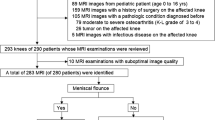Abstract
Objective
To determine the sensitivity and specificity of reported MRI signs in the evaluation of bucket-handle tears of the knee.
Design and patients
A retrospective analysis of 71 knee MR examinations that were read as displaying evidence of a bucket-handle or "bucket-handle type" tear was performed. We evaluated for the presence or absence of the absent bow tie sign, the coronal truncation sign, the double posterior cruciate ligament (PCL) sign, the anterior flipped fragment sign, and a fragment displaced into the intercondylar notch. Sensitivity and specificity were calculated relative to the gold standard of arthroscopy.
Results
Forty-three of 71 cases were surgically proven as bucket-handle tears. The absent bow tie sign demonstrated a sensitivity of 88.4%. The presence of at least one of the displaced fragment signs had a sensitivity of 90.7%. A finding of both the absent bow tie sign and one of the displaced fragment signs demonstrated a specificity of 85.7%. The double PCL sign demonstrated a specificity of 100%. The anterior flipped meniscus sign had a specificity of 89.7%.
Conclusions
Bucket-handle tears of the menisci, reported in about 10% of most large series, have been described by several signs with MRI. This report gives the sensitivity and specificity of MRI for bucket-handle tears using each of these signs independently and in combination. MRI is shown to be very accurate for diagnosing bucket-handle tears when two or more of these signs coexist.







Similar content being viewed by others
References
De Smet A, Graf B. Meniscal tears missed on MR imaging: relationship to meniscal tear patterns and anterior cruciate ligament tears. AJR Am J Roentgenol 1994; 162:905–911.
Crues JI, Mink J, Levy T, Lotysch M, Stoller D. Meniscal tears of the knee: accuracy of MR imaging. Radiology 1987; 164:445–448.
Fischer SP, Fox JM, Del Pizzo W, Friedman MJ, Snyder SJ, Ferkel RD. Accuracy of diagnoses from magnetic resonance imaging of the knee: a multicenter analysis of one thousand and fourteen patients. J Bone Joint Surg Am 1991; 73:2–10.
Shakespeare DT, Rigby HS. The bucket-handle tear of the meniscus: a clinical and arthrographic study. J Bone Joint Surg Br 1983; 65:383–387.
Poeling GG, Ruch DS, Chabon SJ. The landscape of meniscal injuries. Clin Sports Med 1990; 9:539–549.
Wright DH, De Smet AA, Norris M. Bucket-handle tears of the medial and lateral menisci of the knee: value of MR imaging in detecting displaced fragments. AJR Am J Roentgenol 1995; 165:621–625.
Helms CA, Laorr A, Cannon WD. The absent bow tie sign in bucket-handle tears of the menisci in the knee. AJR Am J Roentgenol 1998; 170:57–61.
Singson R, Feldman F, Staron R, Kiernan H. MR imaging of displaced bucket-handle tear of the medial meniscus. AJR Am J Roentgenol 1991; 156:121–124.
Weiss KL, Morehouse HT, Levy IM. Sagittal MR images of the knee: a low signal band parallel to the posterior cruciate ligament caused by a displaced bucket handle tear. AJR Am J Roentgenol 1991; 156:117–119.
Watt A, Halliday T, Raby N. The value of the absent bow tie sign in MRI of bucket-handle tears. Clin Radiol 2000; 55:622–626.
Magee TH, Hinson GW. MRI of meniscal bucket-handle tears. Skeletal Radiol 1998; 17:495–499.
Haramati N, Staron RB, Rubin S, Shreck EH, Feldman F, Kiernan H. The flipped meniscus sign. Skeletal Radiol 1993; 22:273–277.
Author information
Authors and Affiliations
Corresponding author
Additional information
Presented at RSNA 2001 National Meeting, Chicago, Illinois, 26 November 2001
Rights and permissions
About this article
Cite this article
Dorsay, T.A., Helms, C.A. Bucket-handle meniscal tears of the knee: sensitivity and specificity of MRI signs. Skeletal Radiol 32, 266–272 (2003). https://doi.org/10.1007/s00256-002-0617-6
Received:
Revised:
Accepted:
Published:
Issue Date:
DOI: https://doi.org/10.1007/s00256-002-0617-6




